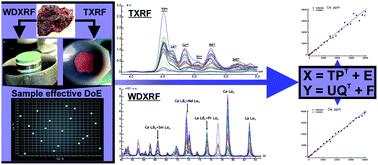当前位置:
X-MOL 学术
›
J. Anal. At. Spectrom.
›
论文详情
Our official English website, www.x-mol.net, welcomes your feedback! (Note: you will need to create a separate account there.)
Three calibration techniques combined with sample-effective design of experiment based on Latin hypercube sampling for direct detection of lanthanides in REE-rich ores using TXRF and WDXRF
Journal of Analytical Atomic Spectrometry ( IF 3.4 ) Pub Date : 2020-11-26 , DOI: 10.1039/d0ja00264j Timur F. Akhmetzhanov 1, 2, 3, 4 , Galina V. Pashkova 4, 5, 6 , Victor M. Chubarov 4, 6, 7 , Timur A. Labutin 1, 2, 3, 4 , Andrey M. Popov 1, 2, 3, 4
Journal of Analytical Atomic Spectrometry ( IF 3.4 ) Pub Date : 2020-11-26 , DOI: 10.1039/d0ja00264j Timur F. Akhmetzhanov 1, 2, 3, 4 , Galina V. Pashkova 4, 5, 6 , Victor M. Chubarov 4, 6, 7 , Timur A. Labutin 1, 2, 3, 4 , Andrey M. Popov 1, 2, 3, 4
Affiliation

|
This study concerns the simultaneous detection of five rare-earth elements (REEs) – Ce, La, Nd, Pr, Sm – in ores and nodules using two X-ray fluorescence techniques (XRF): total reflection (TXRF) and wavelength-dispersive (WDXRF). The issues of high pairwise correlation between REE contents in certified reference materials of natural origin, resulting in a poor quality of calibration sample set, and the significant overlapping of REE lines, especially in TXRF spectra, which have low spectral resolution, are addressed in the study. For the first time, this is done by employing a specially designed calibration set, based on Latin hypercube sampling. Its applicability was assessed for univariate and multivariate (PCR, PLS) calibration models to overcome the above issues. A feature of our calibration set is the use of artificial mixtures of REE oxides and Fe2O3 + TiO2 (as a matrix) providing extremely low correlation (<0.03) between the content of different REEs. Simultaneously, the validation set consists of natural certified reference materials of REE-rich ores and oceanic ferromanganese nodules. The content of each REE in the calibration set varies in the range of 0–40 000 ppm. Our PLS/PCR-based calibration models provide a quantitative determination of Ce, La, and Nd content using both XRF techniques. Pr and Sm were special cases, which cannot be quantitatively determined using univariate calibration, while our multivariate models were able to detect these REEs at a level above 100 ppm.
中文翻译:

三种校准技术结合基于拉丁超立方采样的样本有效设计实验,通过TXRF和WDXRF直接检测富稀土矿石中的镧系元素
这项研究涉及使用两种X射线荧光技术(XRF)同时检测矿石和结核中的5种稀土元素(REE),即Ce,La,Nd,Pr,Sm:全反射(TXRF)和波长分散(WDXRF)。本手册解决了自然来源的认证参考材料中REE含量之间的成对相关性很高,导致校准样品集质量较差,以及REE线显着重叠的问题,尤其是在TXRF光谱中,光谱分辨率较低。研究。这是第一次通过采用基于拉丁超立方体采样的特殊设计的校准集来完成。为克服上述问题,对单变量和多变量(PCR,PLS)校准模型进行了评估,以评估其适用性。2 O 3 + TiO 2(作为基质)在不同稀土元素含量之间具有极低的相关性(<0.03)。同时,验证集由富含稀土元素的矿石和海洋锰铁结核的天然认证参考材料组成。校准集中每个稀土元素的含量在0至40 000 ppm范围内变化。我们基于PLS / PCR的校准模型可使用两种XRF技术对Ce,La和Nd含量进行定量测定。Pr和Sm是特例,无法使用单变量校准进行定量确定,而我们的多变量模型能够以100 ppm以上的水平检测到这些REE。
更新日期:2020-12-10
中文翻译:

三种校准技术结合基于拉丁超立方采样的样本有效设计实验,通过TXRF和WDXRF直接检测富稀土矿石中的镧系元素
这项研究涉及使用两种X射线荧光技术(XRF)同时检测矿石和结核中的5种稀土元素(REE),即Ce,La,Nd,Pr,Sm:全反射(TXRF)和波长分散(WDXRF)。本手册解决了自然来源的认证参考材料中REE含量之间的成对相关性很高,导致校准样品集质量较差,以及REE线显着重叠的问题,尤其是在TXRF光谱中,光谱分辨率较低。研究。这是第一次通过采用基于拉丁超立方体采样的特殊设计的校准集来完成。为克服上述问题,对单变量和多变量(PCR,PLS)校准模型进行了评估,以评估其适用性。2 O 3 + TiO 2(作为基质)在不同稀土元素含量之间具有极低的相关性(<0.03)。同时,验证集由富含稀土元素的矿石和海洋锰铁结核的天然认证参考材料组成。校准集中每个稀土元素的含量在0至40 000 ppm范围内变化。我们基于PLS / PCR的校准模型可使用两种XRF技术对Ce,La和Nd含量进行定量测定。Pr和Sm是特例,无法使用单变量校准进行定量确定,而我们的多变量模型能够以100 ppm以上的水平检测到这些REE。



























 京公网安备 11010802027423号
京公网安备 11010802027423号